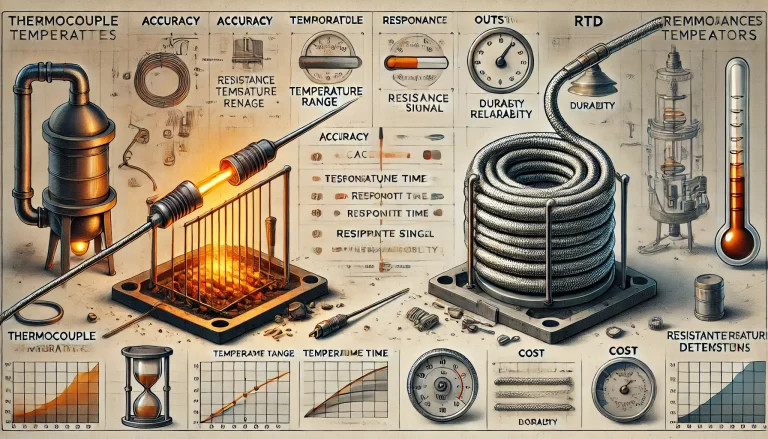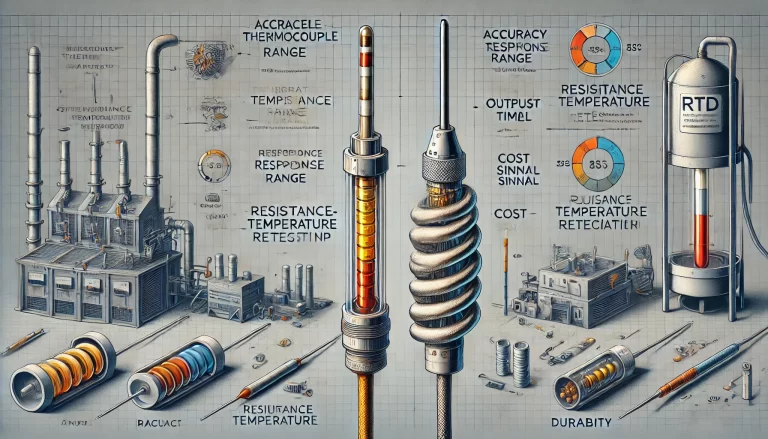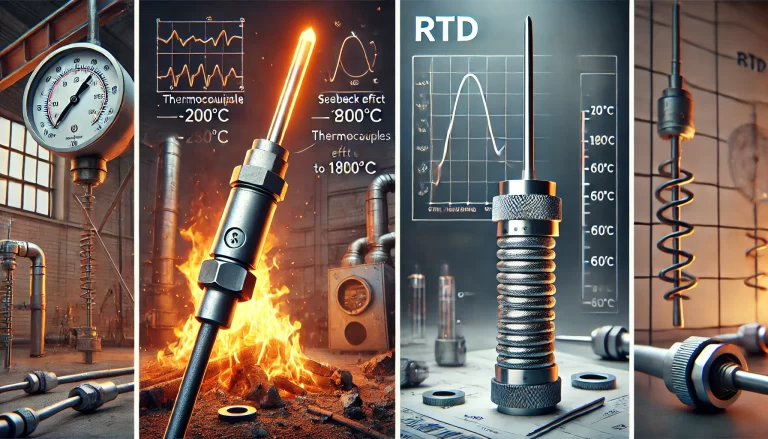Thermocouples and Resistance Temperature Detectors (RTDs) are two of the most commonly used temperature sensors across various industries. Each of these devices has unique characteristics, which makes them suitable for different applications. Understanding the differences between thermocouples and RTDs in terms of working principles, accuracy, measurement range, response time, output signal, cost, and durability is crucial for selecting the right temperature sensor for your specific needs. This article explores these differences in greater detail.
1. Working Principle
Thermocouples: The thermocouple works on the principle of the Seebeck effect, which is a type of thermoelectric effect. This occurs when two wires made from dissimilar metals are joined at one end (called the “hot junction”). When the temperature at the hot junction differs from the other ends of the wires (the “cold junction”), a voltage (electromotive force, or EMF) is produced, proportional to the temperature difference. By measuring this voltage, the temperature at the hot junction can be determined.
RTDs: Resistance Temperature Detectors (RTDs) operate on the principle that the electrical resistance of a metal changes with temperature. As the temperature increases, the resistance of the metal also increases in a predictable and linear fashion. Platinum is often used in RTDs (such as the PT100) due to its stable and repeatable resistance-temperature relationship. The temperature is calculated by measuring the resistance across the metal sensor and correlating it with a known temperature-resistance curve.

2. Accuracy
Thermocouples: While thermocouples can measure a broad range of temperatures, they tend to be less accurate than RTDs. Factors such as electrical noise and electromagnetic interference (EMI) can affect the small voltage generated by the thermocouple, leading to inaccuracies. Thermocouples also exhibit non-linear output over large temperature ranges, requiring more complex signal processing to achieve accurate readings.
RTDs: RTDs are known for their high accuracy and stability, particularly in lower temperature ranges (up to around 600°C). RTDs typically have a linear response to temperature, which makes calibration simpler and more reliable. Platinum-based RTDs (e.g., PT100) are known for having a precision of ±0.1°C, making them ideal for laboratory and industrial applications where precise temperature control is required.
3. Temperature Range
Thermocouples: One of the primary advantages of thermocouples is their ability to measure extremely wide temperature ranges. Depending on the type of thermocouple used (e.g., Type K, Type J, or Type T), thermocouples can measure temperatures from as low as -200°C up to 1700°C or higher. This makes thermocouples ideal for high-temperature environments, such as in kilns, furnaces, and gas turbines.
RTDs: RTDs are typically limited to a narrower temperature range compared to thermocouples. Most RTDs can measure temperatures from -200°C to about 850°C. While this is sufficient for many industrial applications, RTDs are not suitable for environments where temperatures exceed 850°C.

4. Response Time
Thermocouples: Thermocouples generally have faster response times compared to RTDs. Because they are made of simple metal junctions, they can quickly detect and respond to changes in temperature. This makes thermocouples useful in applications where temperature changes rapidly, such as in combustion engines, industrial processes, or when monitoring fluids in motion.
RTDs: RTDs tend to have slower response times due to the physical mass of the sensor element, which is often embedded in a protective sheath. The additional time needed for the temperature to reach equilibrium in the sensor element leads to a slower response. However, RTDs are preferred in applications where temperature stability and precision are more critical than the speed of detection.
5. Output Signal
Thermocouples: Thermocouples produce a millivolt signal that is directly proportional to the temperature difference between the hot junction and the cold junction. However, because the signal is very weak, it often requires amplification and compensation for any environmental effects. The signal from a thermocouple is nonlinear, meaning that specialized equipment or software is needed to accurately interpret the data.
RTDs: RTDs output a resistance signal that varies with temperature. A small current is passed through the RTD, and the resulting voltage drop across the sensor is used to calculate the resistance. This resistance is then converted to temperature using standardized conversion tables. The output of an RTD is much more linear compared to thermocouples, which makes it easier to integrate into most control systems.

6. Cost
Thermocouples: In general, thermocouples are more cost-effective than RTDs, particularly in high-temperature applications. The materials used in thermocouples are inexpensive, and the simple construction of the sensor contributes to lower costs. They are also disposable in many industrial applications, where frequent replacement may be necessary due to harsh conditions.
RTDs: RTDs, especially those made with platinum, are more expensive than thermocouples due to the cost of the material and the more complex manufacturing process. The increased precision, reliability, and longevity of RTDs justify their higher cost in applications where accuracy and stability are critical.
7. Durability and Environmental Suitability
Thermocouples: Thermocouples are typically more durable and resistant to harsh environmental conditions, such as extreme heat, vibration, and pressure. This makes them well-suited for heavy-duty industrial applications, such as in petrochemical plants, steel manufacturing, and aerospace. Thermocouples are often encased in protective materials that enable them to survive in corrosive or abrasive environments.
RTDs: RTDs are more delicate than thermocouples, and they may not perform as well in high-vibration or shock-prone environments. They are more sensitive to physical damage, and the lead wires used in RTDs can be more prone to interference or mechanical failure. However, in controlled environments where accuracy is more important than durability, RTDs are highly reliable.

Conclusion
When choosing between thermocouples and RTDs, the decision largely depends on the specific requirements of the application. Thermocouples are preferred in environments that require broad temperature ranges, fast response times, and cost-effective solutions, especially in harsh or high-temperature conditions. On the other hand, RTDs offer superior accuracy, stability, and linearity, making them ideal for applications requiring precise temperature measurements in controlled settings.
Understanding these differences can help engineers and technicians make the right choice for their temperature sensing needs, optimizing performance, and ensuring accurate results in their processes.
